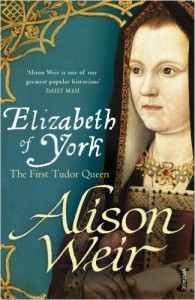When Alison Weir’s biography of Elizabeth of York was published in late 2013, it was hailed as helping to rescue the memory of a ‘forgotten Queen.’
I never thought that was entirely fair. I had certainly been taught about Henry VIII’s mother before I reached secondary education and I struggle to imagine that my school had a particularly outlandish curriculum. But, it’s true to say that the image that comes down to us is deeply unsatisfying.
The almost dowdy mother. The unthinkingly loyal consort. The saintly persona. The woman devoid of sexuality and of sensuality. Could such a person have really produced the rumbustious Henry VIII, the chaotic Queen Margaret of Scotland and the daring Mary Tudor?
This is perhaps why some recent historians and fiction writers have gone too far in readdressing the balance. Here the picture doesn’t fit either. The White Princess. The fearsome loyalist to the House of York. The woman who dreams of lost brothers returning from across the sea. The courageous Queen who fights against the power of her miserly husband and authoritarian mother-in-law. Surely there’s a balance to be struck?
As ever, that is exactly what Weir achieves. By revisiting the contemporary sources, she presents a reconstruction of the Queen which is well-researched, realistic and entirely human. We start to get a glimpse – because perhaps it can only ever be a glimpse – as to what it might have actually been like to be in the presence of this fifteenth century matriarch.
To an extent, the book is counter-revisionist. It reasserts Elizabeth’s genuine closeness to Henry VII (which many have questioned) and good relationship with his mother Margaret Beaufort. It is clear that she was one of the key players that threw herself into making project Tudor a success. She may not, as some have suggested, have explosively fallen out with her own mother – but she knew that her focus was the future.
No reader will be left with the impression that Elizabeth of York was a silent figure in the background. The book is full of examples of where she used her influence, particularly for the good of others, and explores the impact she had on her own children to whom she was perhaps untypically close.
Weir also lets us have a bit of fun. We explore intriguing theories that suggest the young Princess may have cosied up to uncle Richard III more than we might think decent. But she also reminds us exactly which theories we do and do not have evidence to support. While I’m not entirely sure I believe in the genuineness of Elizabeth’s lost letter to the Duke of Norfolk – where she pleads for marriage to her uncle Richard – my huge respect for Weir, who does think it worthy of consideration, means I am going to have to think again.
Perhaps most striking is the author’s discovery that Elizabeth was present at the Tower of London at the time Sir James Tyrell – the man who had supposedly confessed to the murder of her brothers, the Princes in the Tower – was executed. Could it be that she was brought there to hear his confession?
“Elizabeth of York: The first Tudor Queen” is not my favourite Alison Weir offering – I prefer the less one-person focused books such as ‘York Vs Lancaster’ – but it is toward the top of the list. Quite simply, it is a must read for any fan or the era, or indeed anyone who enjoys getting up close and personal to a remarkable figure of history who might otherwise be forever misunderstood.
Elizabeth of York: The First Tudor Queen, by Alison Weir was published by Vintage in 2013. At the time this post was published the book was available on Amazon for £4.99 (Kindle), £15.99 (hardback) and £9.48 (paperback).
